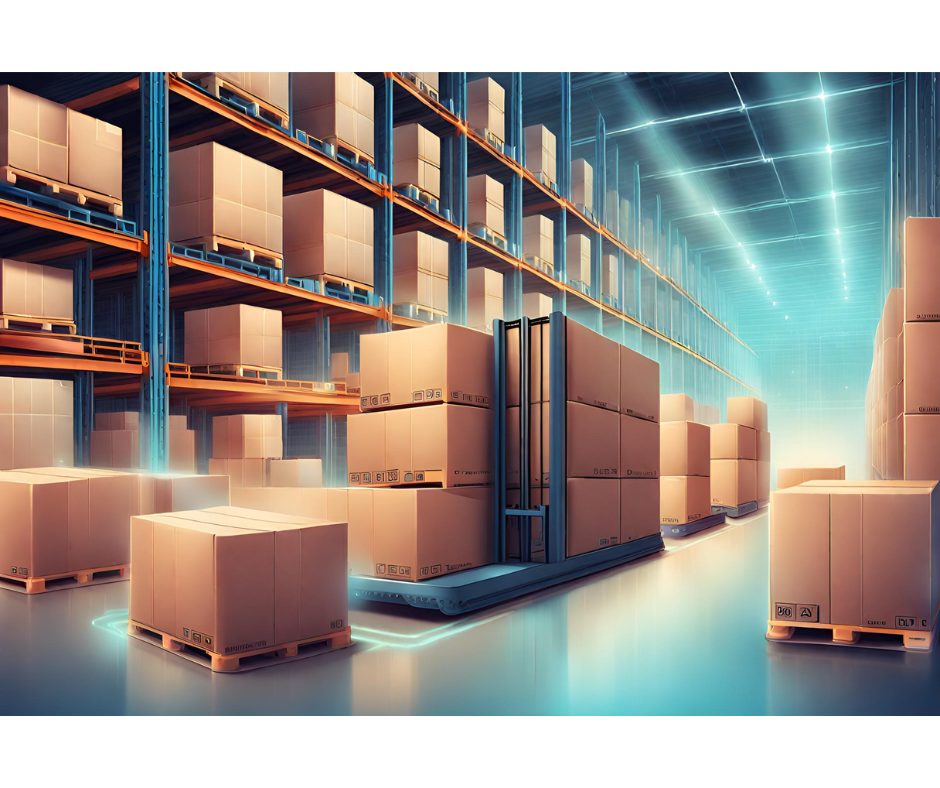Many companies are seeking innovative ways to optimize their operations and gain a competitive advantage in this area. In response to these challenges, warehouse tracking systems have emerged as a crucial innovation.
Stats show that the global e-commerce market is booming. In 2024, it’s at $3.178 trillion, and by 2029, it’ll hit nearly $5 trillion with an average annual growth rate of 9.47%. With the rapid development of the market, warehouse asset management and tracking are becoming critical to ensuring the smooth flow of goods and services.
What is smart/intelligent warehousing?
Smart warehousing is a sophisticated approach to organizing storage based on advanced technologies. The key components of a smart warehouse include:
- Artificial intelligence and machine learning – these systems allow warehouse managers to obtain the necessary information from a large amount of data. Thanks to predictive analytics, you can optimize inventory, anticipate demand for products, and minimize costs in the supply chain.
- IoT-based warehouse tracking system – modern software designed to determine the location of objects and control their movements. Special sensors are installed throughout the warehouse and provide users with detailed information about current warehouse operations.
- Automation involves using conveyor belts, autonomous robots, and automated guided vehicles. This equipment helps optimize order picking, avoid errors, and increase warehouse efficiency.
- Blockchain is a distributed database that allows you to control the supply chain of goods. It increases consumer safety, helps quickly track any supply problems, and reduces financial losses.
- Cloud systems effectively manage warehouse operations. They ensure faster order processing, inventory control, and a complete picture of the warehouse status in real time.
Tracking systems based on IoT equipment
IoT-based tracking systems are based on tags, beacons, and other sensors installed indoors or on monitored objects. At a given interval, they send out radio pulses, which are received by readers and transmitted to servers. Information from sensors is processed using special software and then sent to smartphones or PCs to generate indoor digital maps.
Modern radio frequency positioning technologies, such as Bluetooth® Low Energy, RFID, Wi-Fi, and others ensure the operation of the sensors. They are scalable, easy to install, and use low-power hardware. The system provides companies with the following opportunities:
Tracking the movement of assets and workers in real-time.
The equipment allows you to accurately determine the location of tracked objects and control their movement using digital maps. Thanks to this, it’s possible to more effectively prevent theft of valuable property, ensure constant monitoring of personnel, and determine the availability of employees, delay, time of arrival, and departure from work.
Equipment downtime monitoring.
The technology provides full monitoring of the condition of loaders and vehicles. Using warehouse tracking systems, you can track their movements, determine the total load, and prevent downtime that negatively affects the profit of the business.
Quickly finding the products or equipment you need.
Implementing the system into the warehouse infrastructure simplifies the work of employees. When using the system, staff can quickly find the right products on the shelves, which speeds up order completion and increases customer loyalty. If needed, the technology can be used to quickly search for inventory and equipment in the warehouse, as well as to prevent theft.
Monitoring the completion of tasks.
Through warehouse tracking devices, the administration can monitor the work of employees and the execution of tasks assigned to the staff. This provides opportunities to adjust tasks in real-time and improves worker productivity.
Environmental monitoring.
When introducing warehouse tracking systems, you can use various sensors, such as the ones measuring temperature and humidity in the room. The system monitors them and immediately notifies responsible staff members about deviations from the specified parameters. This is especially important for storing food or medication that requires strict storage conditions.
Creating a safer work environment.
The system radically increases staff safety. Monitoring the movement of equipment in a warehouse helps avoid collisions and increases the administration’s awareness of the current safety situation. Additionally, the technology minimizes the risks of emergencies and reduces the threat to employee health.
Analytics and reports.
Through the platform, detailed information about all aspects of the company’s activities can be collected. The system provides detailed analytics on warehouse workload, inventory issues, and current warehouse stocks. Reporting allows you to optimize warehouse operations, simplifies forecasting demand for a particular product, and prevents overstocking of warehouses.
Benefits of implementing intelligent warehousing
Using a warehouse asset tracking system provides businesses with a wide range of benefits, from real-time product visibility to improved safety, warehouse efficiency, and lower operating costs.
Real-time visibility
Warehouse tracking systems allow you to collect and analyze information about warehouse operations in real-time. Thanks to this approach, warehouse performance gains absolute transparency. The administration can easily track inventory levels, monitor the condition of equipment, and promptly respond to downtime or equipment breakdowns.
Increased work efficiency
Automation combined with warehouse tracking systems helps optimize intelligent warehousing processes and increase business efficiency. As a result, you can expect several benefits, such as:
- reducing order execution times;
- increasing customer satisfaction;
- creating a more sustainable and stable supply chain.
Increased security
Smart warehousing can enhance safety by creating a work environment that minimizes human exposure to hazardous conditions. Complex tasks are performed by automated vehicles and robots, so the risk of emergency incidents in the workplace is reduced and minimized.
Cost reduction
Collectively, these efficiencies in space utilization, waste reduction, and error minimization translate into significant cost savings for companies across storage, labor, and broader logistics operations.
To sum up, smart warehousing sets the stage for a revolution in supply chain management. The combination of automation, tracking systems, and artificial intelligence turns warehouses into “smart” enterprises that quickly and efficiently adapt to current market needs. Thanks to them, companies can more successfully make strategically important decisions and significantly increase their competitiveness.










